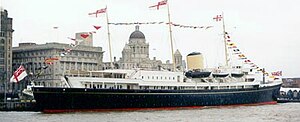Royal Yacht Britannia

Britannia at pierhead on the River Mersey, Liverpool. She is dressed overall.
|
|
| History | |
|---|---|
|
|
|
| Name: | HMY Britannia |
| Owner: | The Royal Yacht Britannia Trust |
| Ordered: | 5 February 1952 |
| Builder: | John Brown & Company |
| Yard number: | 691 |
| Laid down: | 16 June 1952 |
| Launched: | 16 April 1953 |
| Commissioned: | 11 January 1954 |
| Decommissioned: | 11 December 1997 |
| Identification: | IMO number: 8635306 |
| Status: | Museum ship open to the public |
| General characteristics | |
| Tonnage: | 5,769 GT |
| Length: | 412 ft (126 m) |
| Beam: | 55 ft (17 m) |
| Height: | 123 ft (37 m) to top of mainmast |
| Draught: | 15 ft (4.6 m) |
| Propulsion: | Steam, 12,000 hp (8,900 kW) |
| Speed: | 21.5 knots (39.8 km/h; 24.7 mph) |
| Range: | 2,400 nautical miles (4,400 km) |
| Capacity: | 250 guests |
| Troops: | 1 platoon of Royal Marines |
| Crew: |
|
Her Majesty's Yacht Britannia, also known as the Royal Yacht Britannia, is the former royal yacht of the British monarch, Queen Elizabeth II, in service from 1954 until 1997. She was the 83rd such vessel since King Charles II acceded to the throne in 1660, and is the second royal yacht to bear the name, the first being the racing cutter built for the Prince of Wales in 1893. During her 43-year career, the yacht travelled more than a million nautical miles around the globe. Today, she is an award-winning visitor attraction and evening events venue permanently berthed at Ocean Terminal, Leith, in Edinburgh, Scotland, and is visited by over 300,000 tourists each year.
HMY Britannia was built at the shipyard of John Brown & Co. Ltd in Clydebank, West Dunbartonshire. She was launched by Queen Elizabeth II on 16 April 1953, and commissioned on 11 January 1954. The ship was designed with three masts: a 133-foot (41 m) foremast, a 139-foot (42 m) mainmast, and a 118-foot (36 m) mizzenmast. The top aerial on the foremast and the top 20 feet (6.1 m) of the mainmast were hinged to allow the ship to pass under bridges.
Britannia was designed to be converted into a hospital ship in time of war, although this capability was never used. In the event of nuclear war, it was intended for the Queen to take refuge aboard Britannia off the north-west coast of Scotland.
The crew of Royal Yachtsmen were volunteers from the general service of the Royal Navy. Officers were appointed for up to two years, while the "yachtsmen" were drafted as volunteers and after 365 days' service could be admitted to "The Permanent Royal Yacht Service" (upon volunteering and subsequently being accepted) as Royal Yachtsmen and served until they chose to leave the Royal Yacht Service or were dismissed for medical or disciplinary reasons. As a result, some served for 20 years or more. The ship also carried a platoon of Royal Marines when members of the Royal Family were on board.
...
Wikipedia
